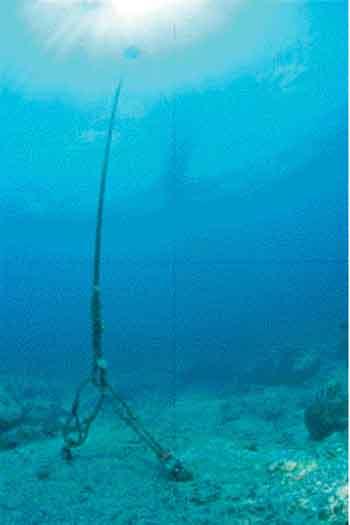LIHU‘E — Clunk. That’s the sound of an anchor being dropped on one of Hawai‘i’s most vital ecosystems — coral reef. It is the living, breathing organism necessary for oceans around the world to thrive. The state Department of Land
LIHU‘E — Clunk.
That’s the sound of an anchor being dropped on one of Hawai‘i’s most vital ecosystems — coral reef.
It is the living, breathing organism necessary for oceans around the world to thrive. The state Department of Land and Natural Resources, along with Malama Kai Foundation and others, aim to help protect it.
At a public workshop Thursday evening at Wilcox Elementary School cafeteria — where only two boaters were actually present to voice their opinions — locations for the placement of potential day-use mooring buoys around the island were discussed.
The moorings serve as an alternative to dropping anchors and are where divers, snorkelers, fishers or other boaters can attach their vessels.
Not only do they help protect coral, especially where heavy boat traffic is concerned, they enhance the lives of other sea creatures, including fish, said Terry O’Halloran of the Malama Kai Foundation, Thursday night.
There are currently 175 legal moorings already located around the Hawaiian Islands and 52 more which are pending implementation.
Kaua‘i has nine moorings in use and 11 more are in the permitting stage.
But with expected population growth, continued damage to reefs is likely if more buoys are not in place, according to the DLNR and Malama Kai Foundation.
“Try to think down the road of where there’s going to be an increase in boating,” O’Halloran told attendees Thursday, regarding the 10-year forecast DLNR is establishing.
“We are looking to develop a sustainable long-term strategy to help protect Hawai‘i’s precious living coral from anchor damage,” said DLNR Chair Laura Thielen, in a press release. “One way to address this is to effectively install, manage and fund a statewide day-use mooring system at sites where vessel activity (motorized or non-motorized) occurs on a regular basis.”
Not every suggestion offered would be viable, said Emma Anders of DLNR’s Division of Aquatic Resources, Thursday.
“But we have to start somewhere and then go to the realty check,” she said.
With state budgets already at an all-time low, appropriating the funding required for installation might complicate matters, O’Halloran added.
“I don’t want to restrict our thinking to how the economy is right now because I want to assume it’s going to be better,” he said before asking participants for suggestions.
While only a handful of locations were recommended Thursday evening, public input is still essential, O’Halloran said.
“We need public input to help us identify such things as: Where are boats anchoring on a regular basis? Are there day-use moorings at these sites? Are there sufficient moorings or too many? Where will boating and anchoring activity increase and where will day-use moorings be needed over the next 10 years?” Thielen said in the release.
“This is a winning situation for everyone in the long run … we need to find a reasonable way this program can have longevity,” O’Halloran said.
“Our goal is to get as broad of a scope of community input as possible,” he added.
To send comments, e-mail moorings@malama-kai.org or call 808-791-4053. For more information, visit www.malama-kai.org.
• Coco Zickos, business and environmental writer, can be reached at 245-3681 (ext. 251) or czickos@kauaipubco.com.


